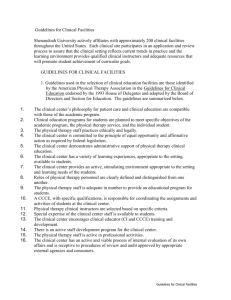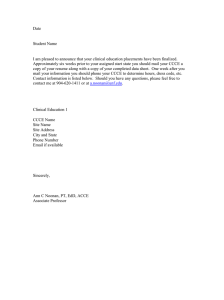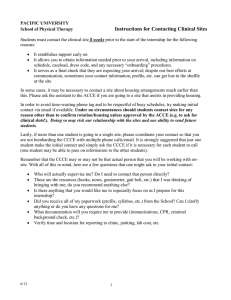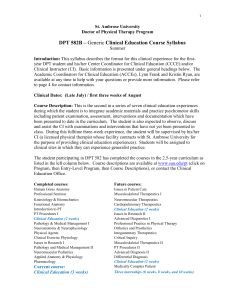Center Coordinators of Clinical Education
advertisement
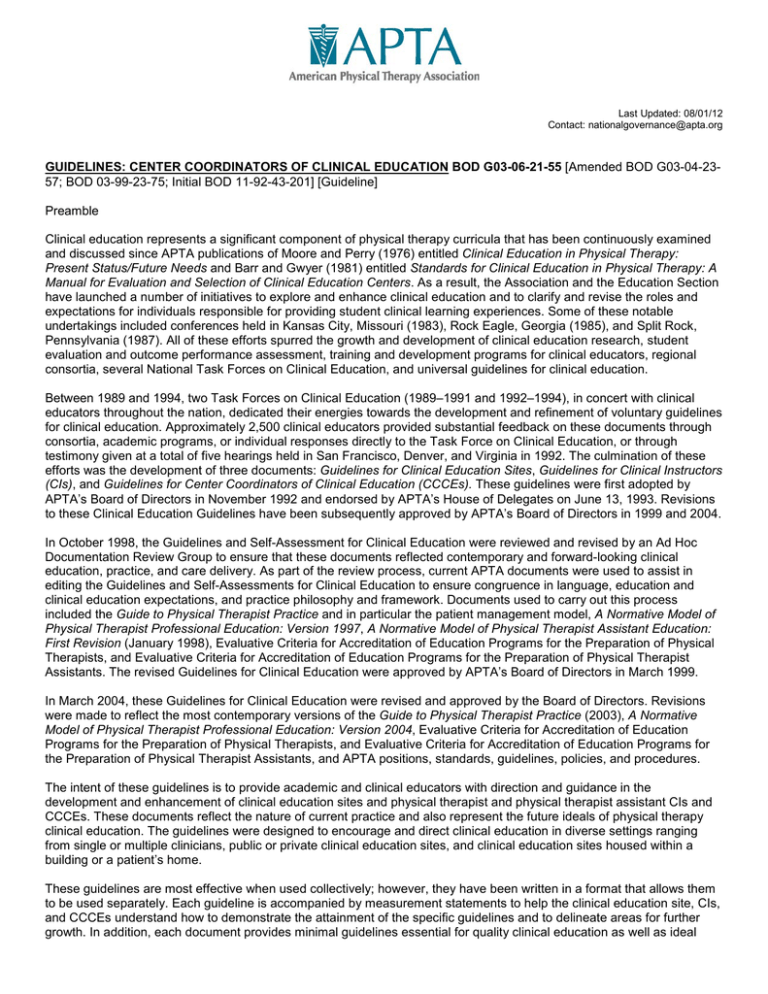
Last Updated: 08/01/12 Contact: nationalgovernance@apta.org GUIDELINES: CENTER COORDINATORS OF CLINICAL EDUCATION BOD G03-06-21-55 [Amended BOD G03-04-2357; BOD 03-99-23-75; Initial BOD 11-92-43-201] [Guideline] Preamble Clinical education represents a significant component of physical therapy curricula that has been continuously examined and discussed since APTA publications of Moore and Perry (1976) entitled Clinical Education in Physical Therapy: Present Status/Future Needs and Barr and Gwyer (1981) entitled Standards for Clinical Education in Physical Therapy: A Manual for Evaluation and Selection of Clinical Education Centers. As a result, the Association and the Education Section have launched a number of initiatives to explore and enhance clinical education and to clarify and revise the roles and expectations for individuals responsible for providing student clinical learning experiences. Some of these notable undertakings included conferences held in Kansas City, Missouri (1983), Rock Eagle, Georgia (1985), and Split Rock, Pennsylvania (1987). All of these efforts spurred the growth and development of clinical education research, student evaluation and outcome performance assessment, training and development programs for clinical educators, regional consortia, several National Task Forces on Clinical Education, and universal guidelines for clinical education. Between 1989 and 1994, two Task Forces on Clinical Education (1989–1991 and 1992–1994), in concert with clinical educators throughout the nation, dedicated their energies towards the development and refinement of voluntary guidelines for clinical education. Approximately 2,500 clinical educators provided substantial feedback on these documents through consortia, academic programs, or individual responses directly to the Task Force on Clinical Education, or through testimony given at a total of five hearings held in San Francisco, Denver, and Virginia in 1992. The culmination of these efforts was the development of three documents: Guidelines for Clinical Education Sites, Guidelines for Clinical Instructors (CIs), and Guidelines for Center Coordinators of Clinical Education (CCCEs). These guidelines were first adopted by APTA’s Board of Directors in November 1992 and endorsed by APTA’s House of Delegates on June 13, 1993. Revisions to these Clinical Education Guidelines have been subsequently approved by APTA’s Board of Directors in 1999 and 2004. In October 1998, the Guidelines and Self-Assessment for Clinical Education were reviewed and revised by an Ad Hoc Documentation Review Group to ensure that these documents reflected contemporary and forward-looking clinical education, practice, and care delivery. As part of the review process, current APTA documents were used to assist in editing the Guidelines and Self-Assessments for Clinical Education to ensure congruence in language, education and clinical education expectations, and practice philosophy and framework. Documents used to carry out this process included the Guide to Physical Therapist Practice and in particular the patient management model, A Normative Model of Physical Therapist Professional Education: Version 1997, A Normative Model of Physical Therapist Assistant Education: First Revision (January 1998), Evaluative Criteria for Accreditation of Education Programs for the Preparation of Physical Therapists, and Evaluative Criteria for Accreditation of Education Programs for the Preparation of Physical Therapist Assistants. The revised Guidelines for Clinical Education were approved by APTA’s Board of Directors in March 1999. In March 2004, these Guidelines for Clinical Education were revised and approved by the Board of Directors. Revisions were made to reflect the most contemporary versions of the Guide to Physical Therapist Practice (2003), A Normative Model of Physical Therapist Professional Education: Version 2004, Evaluative Criteria for Accreditation of Education Programs for the Preparation of Physical Therapists, and Evaluative Criteria for Accreditation of Education Programs for the Preparation of Physical Therapist Assistants, and APTA positions, standards, guidelines, policies, and procedures. The intent of these guidelines is to provide academic and clinical educators with direction and guidance in the development and enhancement of clinical education sites and physical therapist and physical therapist assistant CIs and CCCEs. These documents reflect the nature of current practice and also represent the future ideals of physical therapy clinical education. The guidelines were designed to encourage and direct clinical education in diverse settings ranging from single or multiple clinicians, public or private clinical education sites, and clinical education sites housed within a building or a patient’s home. These guidelines are most effective when used collectively; however, they have been written in a format that allows them to be used separately. Each guideline is accompanied by measurement statements to help the clinical education site, CIs, and CCCEs understand how to demonstrate the attainment of the specific guidelines and to delineate areas for further growth. In addition, each document provides minimal guidelines essential for quality clinical education as well as ideal guidelines to foster growth in the clinical education site, CI, and CCCE. Minimal guidelines are expressed through the active voice while ideals are designated by the use of “should” and “may.” We are indebted to all of the clinical educators and educators who since 1993 have provided feedback and comments on these documents during their initial development through the process of widespread consensus building. Likewise, the contributions of Barr, Gwyer, and Talmor’s Standards for Clinical Education in Physical Therapy (1981) and the Northern California Clinical Education Consortium’s Self-Assessment of a Physical Therapy Clinical Education Site were instrumental to the initial development of the guidelines and self-assessment tools. We are also grateful to the Ad Hoc Documentation Review Group that participated in the process of revising the Guidelines and Self-Assessments for Clinical Education in 1999. APTA is committed to ensuring that these guidelines and self-assessment tools continue to reflect contemporary and forward-looking standards for clinical education that are congruent with expectations for physical therapy education and practice. 1.0 THE CENTER COORDINATOR OF CLINICAL EDUCATION (CCCE) HAS SPECIFIC QUALIFICATIONS AND IS RESPONSIBLE FOR COORDINATING THE ASSIGNMENTS AND ACTIVITIES OF STUDENTS AT THE CLINICAL EDUCATION SITE. 1.1 1.2 1.3 2.0 To qualify as a Center Coordinator of Clinical Education (CCCE), an individual should meet the Guidelines: Center Coordinators of Clinical Education. Preferably, a physical therapist or a physical therapist assistant is designated as the CCCE. Various alternatives may exist, including, but not limited to, nonphysical therapist professionals who possess the skills to organize and maintain an appropriate clinical education program. 1.1.1 If the CCCE is a physical therapist or physical therapist assistant, he or she should be experienced as a clinician; experienced in clinical education; interested in students; possess good interpersonal communication and organizational skills; knowledgeable about the clinical education site and its resources; and serve as a consultant in the evaluation process of students. 1.1.1.1 The CCCE meets the requirements of APTA’s Guidelines for Clinical Instructors. 1.1.2 If the CCCE is not from the physical therapy profession, the CCCE should be experienced in clinical education; interested in students; possess good interpersonal communication and organizational skills; knowledgeable of the clinical education site and its resources; and serve as a consultant in the evaluation process of students. A physical therapist or physical therapist and physical therapist assistant who are experienced clinicians must be available for consultation in planning clinical education experiences for students. Direct clinical supervision of a physical therapist student is delegated to a physical therapist. Direct clinical supervision of a physical therapist assistant student is delegated to either a physical therapist or physical therapist working with a physical therapist assistant. 1.1.2.1 The CCCE meets the non-discipline-specific APTA Guidelines: Clinical Instructors (i.e., Guidelines 2.0, 3.0, 4.0, and 5.0). The CCCE demonstrates knowledge of contemporary issues of clinical practice, management of the clinical education program, educational theory, and issues in health care delivery. The CCCE demonstrates ethical and legal behavior and conduct that meets or exceeds the expectations of members of the profession of physical therapy. THE CENTER COORDINATOR OF CLINICAL EDUCATION DEMONSTRATES EFFECTIVE COMMUNICATION AND INTERPERSONAL SKILLS. 2.1 The CCCE interacts effectively and fosters collegial relationships with parties internal and external to the clinical education site, including students, clinical education site personnel, and representatives of the academic program. 2.1.1 The CCCE performs administrative functions between the academic program and clinical education site, including, but not limited to, completion of the clinical center information forms (CCIF), clinical education agreements, student placement forms,* and policy and procedure manuals. 2.1.2 The CCCE provides consultation to the clinical instructor (CI) in the evaluation process regarding clinical learning experiences. 2.1.3 The CCCE serves as a representative of the clinical education site to academic programs. 2.1.4 The CCCE is knowledgeable about the affiliated academic programs and their respective curricula and disseminates the information to clinical education site personnel. 2.1.5 The CCCE communicates with the Academic Coordinator of Clinical Education* (ACCE) regarding clinical education planning, evaluation, and CI development. 2.1.6 The CCCE is open to and encourages feedback from students, CIs, ACCEs, and other colleagues. 2.1.7 3.0 THE CENTER COORDINATOR OF CLINICAL EDUCATION DEMONSTRATES EFFECTIVE INSTRUCTIONAL SKILLS. 3.1 3.2 3.3 3.4 3.5 4.0 The CCCE demonstrates cultural competence with respect for and sensitivity to individual and cultural differences. The CCCE plans and implements activities that contribute to the professional development of the CIs. 3.1.1 The CCCE is knowledgeable about the concepts of adult and lifelong learning and life span development. 3.1.2 The CCCE recognizes the uniqueness of teaching in the clinical context. The CCCE identifies needs and resources of CIs in the clinical education site. The CCCE, in conjunction with CIs, plans and implements alternative or remedial learning experiences for students experiencing difficulty. The CCCE, in conjunction with CIs, plans and implements challenging clinical learning experiences for students demonstrating distinctive performance. The CCCE, in conjunction with CIs, plans and implements learning experiences to accommodate students with special needs. THE CENTER COORDINATOR OF CLINICAL EDUCATION DEMONSTRATES EFFECTIVE SUPERVISORY SKILLS. 4.1 5.0 The CCCE supervises the educational planning, clinical experiences, and performance evaluation of the CI(s)/students(s) team. 4.1.1 The CCCE provides consistent monitoring and feedback to CIs about clinical education activities. 4.1.2 The CCCE serves as a resource to both CIs and students. 4.1.3 The CCCE assists in planning and problem solving with the CI(s)/student(s) team in a positive manner that enhances the clinical learning experience. THE CENTER COORDINATOR OF CLINICAL EDUCATION DEMONSTRATES EFFECTIVE PERFORMANCE EVALUATION SKILLS. 5.1 5.2 5.3 5.4 6.0 The CCCE is knowledgeable about educational evaluation methodologies and can apply these methodologies to the physical therapy clinical education program. The CCCE contributes to the clinical education site's process of personnel evaluation and development. The CCCE provides feedback to CIs on their performance in relation to the Guidelines for Clinical Instructors. 5.3.1 The CCCE assists CIs in their goal setting and in documenting progress toward achievement of these goals. The CCCE consults with CIs in the assessment of student performance and goal setting as it relates to specific evaluative criteria established by academic programs.* 5.4.1 For student remedial activities, the CCCE participates in the development of an evaluation plan to specifically document progress. THE CENTER COORDINATOR OF CLINICAL EDUCATION DEMONSTRATES EFFECTIVE ADMINISTRATIVE AND MANAGERIAL SKILLS. 6.1 6.2 6.3 6.4 The CCCE is responsible for the management of a comprehensive clinical education program. 6.1.1 The clinical education program includes, but is not limited to, the program's goals and objectives; the learning experiences available and the logistical details for student placements; and a plan for CI training, evaluation, and development. 6.1.2 The CCCE implements a plan for program review and revision that reflects the changing health care environment. The CCCE advocates for clinical education with the clinical education site's administration, the provider of physical therapy's administration, and physical therapy personnel. The CCCE serves as the clinical education site's formal representative and liaison with academic programs. 6.3.1 Activities include scheduling; providing information, documentation, and orientation to incoming students; and maintaining records of student performance, CI qualifications, and clinical education site resources. The CCCE facilitates and maintains the necessary documentation to affiliate with academic programs. 6.4.1 The CCCE maintains current information, including clinical site information forms (e.g., CSIF), clinical education agreements, and policy and procedure manuals. 6.5 6.6 6.7 The CCCE has effective relationships with clinical education site administrators, representatives of other disciplines, and other departments to enhance the clinical education program. The CCCE demonstrates knowledge of the clinical education site's philosophy and commitment to clinical education. The CCCE demonstrates an understanding of the clinical education site's quality improvement and assessment activities. The foundation for this document is: Barr JS, Gwyer J. Standards for Clinical Education in Physical Therapy: A Manual for Evaluation and Selection of Clinical Education Centers. Alexandria, VA: American Physical Therapy Association; 1981:3-8. Evaluative Criteria for Accreditation of Education Programs for the Preparation of Physical Therapists. 19971998 Accreditation Handbook. Alexandria, Va: American Physical Therapy Association;1997: 42-74. Moore ML, Perry JF. Clinical Education in Physical Therapy: Present Status/Future Needs. Alexandria, Va: American Physical Therapy Association and the Section for Education; 1976. The development of this document was a result of combined efforts of the Task Force on Clinical Education, 1989-1991 and the Task Force on Clinical Education 1992-1994. Revisions of this document are based on: 1. 2. 3. 4. 5. 6. 7. American Physical Therapy Association. Guide to Physical Therapist Practice. June 2003. Originally nd published as Guide to Physical Therapist Practice. 2 ed. Phys Ther. 2001; 81: 9-744. American Physical Therapy Association. A Normative Model of Physical Therapist Professional Education: Version 2000. Alexandria, Va: American Physical Therapy Association; 2000. American Physical Therapy Association. A Normative Model of Physical Therapist Assistant Education: Version 99. Alexandria, Va: American Physical Therapy Association; 1999. American Physical Therapy Association. Physical Therapist Clinical Performance Instrument. Physical Therapy Clinical Performance Instruments. Alexandria, Va: American Physical Therapy Association; 1998. American Physical Therapy Association. Physical Therapist Assistant Clinical Performance Instrument. Physical Therapy Clinical Performance Instruments. Alexandria, Va: American Physical Therapy Association; 1998. Commission on Accreditation in Physical Therapy Education. Evaluative Criteria for Accreditation of Education Programs for the Preparation of Physical Therapists. Alexandria, Va: American Physical Therapy Association; 1998. Commission on Accreditation in Physical Therapy Education. Evaluative Criteria for Accreditation of Education Programs for the Preparation of Physical Therapist Assistants. Alexandria, Va: American Physical Therapy Association; 2002. Relationship to Vision 2020: Doctor of Physical Therapy; (Academic/Clinical Education Affairs Department, ext 3203) Explanation of Reference Numbers: BOD P00-00-00-00 stands for Board of Directors/month/year/page/vote in the Board of Directors Minutes; the "P" indicates that it is a position (see below). For example, BOD P11-97-06-18 means that this position can be found in the November 1997 Board of Directors minutes on Page 6 and that it was Vote 18. P: Position | S: Standard | G: Guideline | Y: Policy | R: Procedure
